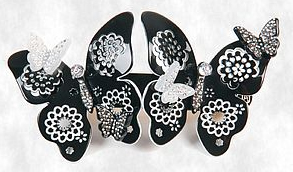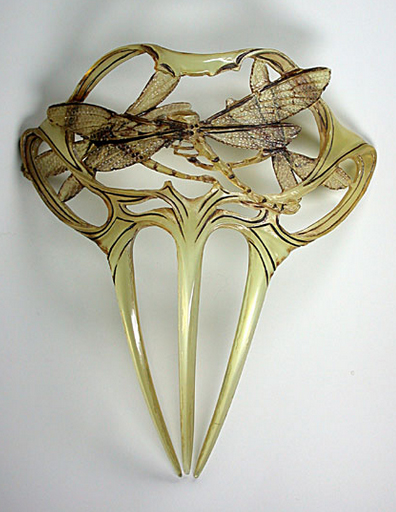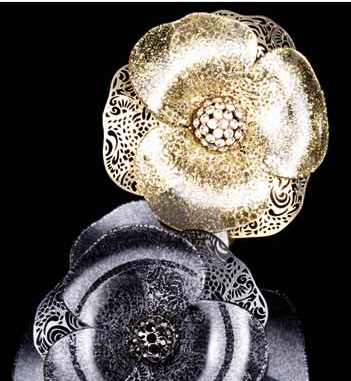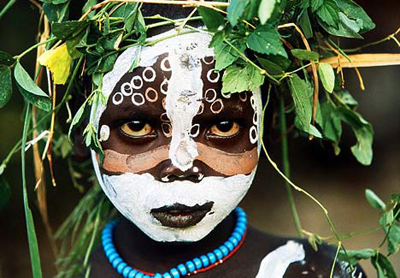The one I bought :-)

The one I didn’t buy. :-(


The one I bought :-)

The one I didn’t buy. :-(

From the Creative Museum
This elegant painted horn comb touches those who have Lalique hearts. Even though the design is layered, the transparency allows light to shine through the comb, perfectly expressing a dragonfly in real life.

This butterfly tiara is made from acrylic plastic, where one color slumbers into another. A black butterfly outline is put on top to define each shape and mimic plique a jour enamel. I’m afraid to call the New York store and ask what this costs. When the company creates a piece like this, they may make three of them.

c.1904 – 1905. The comb is horn, the brim is gold, the leaves are tortoiseshell, and the diamonds make them look like ice.

There was an excellent doctoral thesis done on Lalique by Fallon Lee Miller of Eastern Michigan University in 2003. Beautifully referenced for scholarly research. I recommend taking the time to read it.
by the Creative Museum:
From the Fourteenth Century, Dieppe sailors docked their boats on the coast of Guinea to collect ivory. Instead of selling their precious raw material to Paris workshops, they learned to carve great works of art themselves and kept the profit.
The bindweed flowers carved onto this ivory diadem are hinged to a tortoiseshell comb. It was probably made in Dieppe, France, c. 1850 – 1870.


Lalique’s cattleya orchid is made of ivory, gold, enamel, horn, and diamonds, c. 1903-1904, and resides in the Cleveland Museum of Art. However, the view we usually see of it does not reveal its secret: what René was really thinking when he made it. Last night, I found the truth. Blessed be the genius who loves a woman’s body with his flowers.
Par le Musée Creative
L’Art nouveau est un mouvement artistique qui naît en Europe à la fin du XIXe siècle et rencontre un succès immédiat. Il se développe même internationalement et prend des noms différents selon les pays qui l’adoptent: Tiffany aux Etats-Unis, Skonvirke au Danemark, Stile Liberty en Italie, etc…Le terme français « Art nouveau » s’est imposé en France et même en Grande-Bretagne.
Ce style s’appuie essentiellement sur l’esthétique des lignes courbes. Ses thèmes de prédilection sont la nature, la femme et la mythologie. De grands artistes comme René Lalique ou Lucien Gaillard ont créé des ornements de coiffures somptueux, très recherchés aujourd’hui. Plus modestement, de nombreux artisans français se sont inspirés de leurs créations et ont façonné des peignes ou des épingles au design très poétique. L’ornement de coiffure Art Nouveau français est le plus souvent en corne claire que l’on peint pour imiter la nature. Il est parfois embelli de pierres, de perles ou de métal précieux comme l’or ou l’argent.
Creative Museum possède une collection exceptionnelle d’ornements de coiffure Art Nouveau. Pour ceux qui veulent en savoir plus, ne manquez pas en septembre prochain, notre prochaine exposition qui sera entièrement consacrée à ce style. Voici quelques pièces à admirer en avant-première.
(You may read the English translation in the first comment.)
Copyright: www.creative-museum.com

As Napoleon’s passionate love, Josephine, kneels before him at his coronation, she introduced two enduring jewelry designs: a woman’s laurel-leaf tiara and a comb with round stones on a stem, forever to be known as the Peigne Josephine. She is wearing the comb in the middle of her head to secure a braid. Napoleon’s laurel-leaf crown imitated Ceasar’s. But Jacques Louis David’s landmark 1804 painting allows us to contemplate Josephine as one of the great jewelry innovators of her time.
Some Selections from the Winter 2011 collection. You can only get them in stores, and they sell for thousands now. I would pick all of these and have them sent as a matter of principle.
Butterfly Tiara
Rare Mother of Pearl flower barrettes
Art Deco Butterflies
Camelias
Art Deco Lily Tiara
Art Nouveau’s dedication to the natural world ignited European artists from 1890 – 1905. However, brilliant design has many faces, among them fashion still worn today. In the book, Natural Fashion: Tribal Decoration from Africa, author Hans Sylvester reveals a fashion revolution in design thinking: Art Nouveau and Art Deco meld into a single concept as plants and bold natural colors decorate the body and face. John Paul Gaultier, take notice. What the Surma and Mursi tribes of East Africa’s Omo Valley have created is worthy of the most elite haute couture runways.



